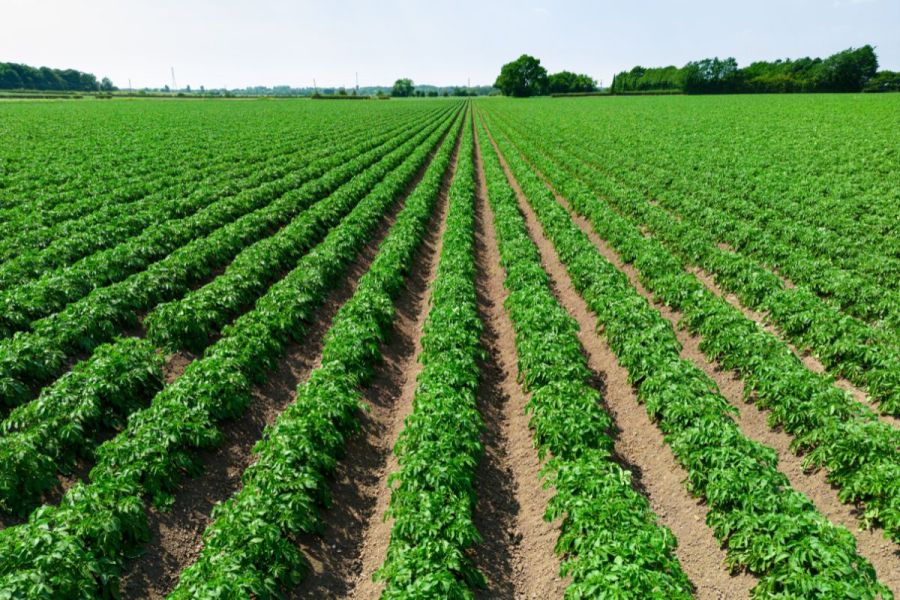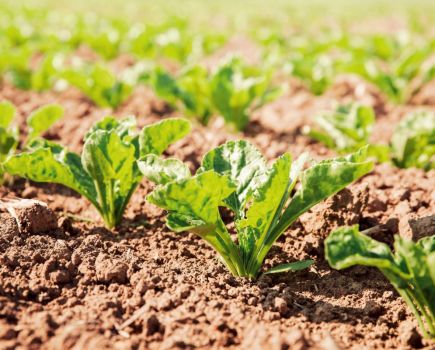Developing lower intensity potato cultivations could help growers to improve soil health and save money, but stone content remains a challenge. CPM investigates the latest research which aims to address this.
“If we want to have very low soil disturbance, we have to stop destoning and bed tilling.”
By Mike Abram
A multi-million-pound project is starting to show that reducing the intensity of potato cultivations is possible without impacting yields. But better understanding of stone content in soils is likely to be required to unlock wider adoption.
The four-year Potato-LITE (Low Intensity Tillage Enhancement) project was awarded £2.83M to explore optimised systems for potato cultivations through the Innovate UK Farming Innovation Programme in March 2023.
While reduced tillage technologies have enabled regenerative agriculture in cereal systems, they’ve not been particularly well-developed for root crops, where production systems require the soil to be cultivated to create a deep seedbed – free from stones and clods – to provide a favourable environment for growth and damage avoidance.
Typical ‘maxi-till’ for potatoes involves multiple passes of primary cultivations, such as the plough or deep non-inversion cultivators, followed by bed formers, bed tillers and destoners before the crop is planted.
“Many of these operations are excessively deep,” says Mark Stalham, an independent potato consultant and researcher working on the Potato-LITE project. “A destoner can typically sieve 6500t/ha of soil and stone. A bed tiller cultivates a similar amount of soil while a plough would invert that volume of soil involving more energy and more disturbance.”
One key aspect of the project has been to find a method for quantifying the intensity of various potato cultivation operations to give a baseline to work from when reducing cultivations.
A metric used by the US Department of Agriculture’s National Resources Conservation Service proved ideal, says agricultural engineer Philip Wright of Wright Resolutions, which he’s been developing for use in the potato crop with McCain for some years. “It’s part of an algorithm used to look at soil loss and indirectly, trends in soil carbon,” he explains.
As part of that calculation, it uses a soil tillage intensity rating (STIR), assessed using the operational speed of tillage equipment, tillage type, depth of tillage operation and percent of the soil surface area disturbed.
“STIR is driven by the type of operation. For example, mouldboard ploughing is quite intensive; low disturbance soil lifting and loosening will have a lower factor, and if we only tilled strips across the field rather than the whole field, it would be even less.”
Speed is also a key factor. For non-powered operations, the faster you go, the more intensively you move soil and the more energy you put in, so the higher the STIR. The depth you work at and the amount of soil moved across the working width also comes into this, says Philip.
For powered operations such as bed tilling, the slower you drive the higher the intensity. “It has more time to deliver energy to the soil,” he explains. Destoning also has an inverse relationship with working speeds. “The closer the web or star spacing, the longer it takes to filter out soil and the slower you have to drive.”
Soil tillage intensity ratings have been calculated for each operation and machine according to depth, including planting and harvesting.
“Harvesting is effectively like a destoner at the end of the season,” adds Mark. “But the soil might be in a very different state, either extremely dry or extremely wet. The level of impact is related to the dryness of the soil but if the harvester is moving very slowly, then this is likely to have a greater impact. So it’s possible to compromise soils at both ends of the season.”
Even within a traditional establishment system there’ll be potential for optimisation, stresses Mark. “We can work soil more shallowly, use wider pitch webs, and run powered rotary equipment less aggressively.”
Destoning, however, normally has the highest STIR along with bed tilling. “If we want to have very low soil disturbance, we have to stop destoning and bed tilling as the default practice,” he suggests.
Using STIR for maxi-till establishment as the benchmark, the project team has tested three novel alternative establishment methods with much lower STIR values on four potato farms.
The 2023 trials involved growing an overwintered cover crop provided by Kings ahead of the potato crop, and then using either a rotary cultivator or low disturbance tine ahead of the planter. The last option was using the low disturbance tine without a cover crop.
“We envisage the rotary cultivator system being able to create ridges where we have the potential for cloddy soil, so sandy clay loams or heavier, where fixed tine tillage would not create enough fine tilth,” explains Mark.
The STIR value for that system is just 40% of conventional establishment with work rates almost doubled while using two-thirds of the fuel.
Using the prototype Grange toolbar with low disturbance tine following a cover crop reduces tillage intensity to just 15%, with further improvements in work rates and fuel use, while removing the cover crop brings the STIR down to just 7%.
“The key thing is work rate. If we can work soil faster, we can target cultivation into windows when the soil is in a fit state,’ stresses Mark. “Coming shallower conventionally will be an improvement, but the work rate improvements from this more min-tillage approach are massive. You can plant areas very quickly.”
It may also have a knock-on impact on reducing greenhouse gas emissions (GHG), he points out. This is being measured as part of the project, although data is yet to be analysed. “Current understanding is that STIR and GHG emissions go hand-in-hand – if you move a lot of soil intensively when it’s warm and wet, you’ll get a lot of gas losses.”
Yields were marginally lower on average for the experimental systems, although they weren’t significantly different due to considerable variation between the three farms where the systems were tested in 2023. Some practical observations taken in the first year should help improve yields this season, suggests Philip.
For example, in the first year, some of the novel establishment systems were used straight into a living cover crop which created significant challenges for both the cultivations and planting, with the cover crop holding on to aggregates bound to its root system.
“If you have a non-powered piece of kit, it’s difficult to shake those aggregates off, and form a ridge when there are big lumps of root mass glued together,” he says. “You have lumps of root ball going through a planter not designed to cope with it. It doesn’t take much for soil flow to be slowed and result in a poorly formed ridge, where tubers aren’t covered properly.”
Those problems have resulted in two changes for 2024. Firstly, terminating the cover crop earlier – around 4-6 weeks ahead of planting – to allow its roots to die and not bind aggregates.
“A cover crop has to condition the soil over winter to be able to use a minimum tillage system,” comments Mark. “But a cover crop creates virtually all its porosity in the soil by the end of January – killing it then results in 95% of the benefit.”
Leaving it until later, as well as creating potential issues with establishment in this system, also adds more workload for growers, he points out.
The second improvement is a planter which could process that type of soil better. Working with project partner Grimme, a new Prios planter has been provided with less passive sliding and more rotating disc type action which moves the soil during ridge formation, explains Philip. “It’s a planter for minimum tillage and has the capability for material to flow through. Albeit, it still requires the right soil aggregation and quality, which is where cover crop termination time comes in.”
Another tweak was to the Grange toolbar, which now has greater clearance and can undertake some surface cultivation, adds Philip. “The principle with the Grange is to zone cultivate where required with a leg in line with where the potatoes are being planted. Between those deep legs the Grange can now cultivate shallowly to provide tilth. We’ve made a big jump forward with the improvements this season.”
Indeed, Mark suggests it’s difficult to see differences across the cultivation systems this season to the extent he thinks yield differences should be unlikely.
That leaves two major challenges: harvesting speeds and efficiency, and stones. Harvesting rates in 2023 were on average 14-18% slower. “That concerns me,” admits Mark. “There’s no point in being three times quicker at planting if you can’t get the crop out of the ground in time.”
Last year’s results had an element of drivers being a little cautious about what they might find and perhaps in future could go quicker, he suggests. But ultimately, not destoning where required will always create harvesting issues. “There’s not much harvester drivers can do if they pick up stone – it will damage the crop and harvesting will be slower.”
While in the trials in 2023 there wasn’t any consistent bruising difference between systems, the exception was on very stony sites where higher levels were seen which Mark says is pretty obvious.
On those types of sites, destoning is likely to be required. But commercially, destoning depths have started to reduce – finished beds of 28cm depth are becoming more of a standard than 35cm – following research by Mark and Philip.
The project is also looking at whether alternative destoning techniques could be an option – understanding the stone content of soils is going to be critical for knowing what establishment system is most appropriate, says Mark.
“We don’t know what the minimum stone content should be to advise growers whether they should destone or not.”
With the ultimate aim of creating a decision support tool for growers to use to decide on cultivation strategy, such an ability will be vital to enable the right advice to be followed, he concludes.
This article was taken from the latest issue of CPM. Read the article in full here.
For more articles like this, subscribe here.
Sign up for Crop Production Magazine’s FREE e-newsletter here.




